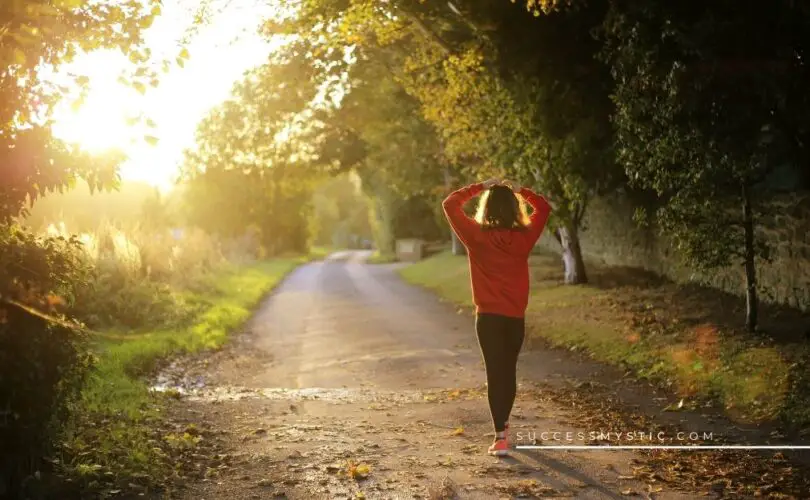“You didn’t come into this world. You came out of it, like a wave from the ocean. You are not a stranger here.”
– Alan Watts
The next time you are feeling stressed out, find the nearest group of trees and go there. Walk slowly among them. Breathe deeply. Open all your senses to the sights, sounds, smells, and textures of nature and feel the healing power of the earth. In Japan, this practice is known as Shinrin-yoku, which translates to “forest bathing” or “taking in the forest atmosphere.” While the method is relatively new, the results are something healers have known about for centuries.
Forest bathing is just one activity that helps you reap the benefits of spending more time outdoors. Exposing yourself to natural elements, fresh air, and sunshine can not only improve your health but also boost your mental wellness in significant ways.
How Nature Affects Your Mental Health
The fact that nature calms the mind is not a surprising revelation. Especially for those who live and work in busy, urban environments, spending time in nature creates a sense of peace that is lacking in our daily lives. The effects that being outdoors and surrounded by natural elements goes beyond just relaxation, though, and can improve how your brain functions, your overall mood and emotional stability, and many other aspects of your emotional and mental health. Below, we dig deeper into the numerous benefits that being outside can have on your mental and emotional well-being.
1| Nature’s Influence on Depression
For those that are vulnerable to depression or suffer from bouts of this mental illness, spending more time outside could help. Reconnecting with the natural world has been shown to ease depression symptoms in many cases, as it promotes gratitude as well as mindfulness, which are both connected to improved outlooks.
Spending time outdoors provides you with a quiet escape from worries and stress that can make depression symptoms worse, and the more time you spend in nature, the better able you are to gain clarity and focus, which can help improve your mood, as well.
Being outside also encourages you to be more active, which plays a significant role in depression, as well. When you exercise, you have more energy, but activity also helps you feel more positive. When you exercise, your body releases endorphins, natural chemicals that create pleasurable feelings.
A recent study that was published in the Journal of Affective Disorders notes that participants with depression who walked for 50 minutes in a natural setting had improvements in their mood. In addition, there was also a noticeable increase in their memory span, which indicates a further influence on the mind, which we discuss further below.
2| Nature Improves Your Cognition and Creativity
The next time you are having trouble solving a problem or find yourself lacking focus, take a break and walk outside. Time spent in nature boost creativity, improves thinking and problem-solving, and can help you remember things more effectively.
One of the reasons for this improvement is that spending time outside reduces stress and anxiety, which often result in annoying, distracting thoughts that detract from your focus. Walking is an excellent way to improve circulation, including to the brain, and this boost of oxygen is also responsible for helping you to think more clearly and feel better prepared mentally to return to your task.
3| How Nature Helps Improve Sleep
Sleep disorders are a mental health issue because of the profound influence that sleep has on how effectively the mind works. Sleep disorders are common among those with mental health disorders such as depression or anxiety, and just a small amount of sleep deprivation can cause changes in how your mind processes information and manages emotions.
When you walk outdoors and spend time in natural light, you can improve your sleep patterns and quality. Exposure to natural light regulates your circadian rhythm, which is your body’s natural sleep-wake cycle.
A strong dose of sunlight each day allows you to maintain a more regular pattern that gives you higher quality, more restful sleep, which leaves you feeling more mentally ready to handle your life.
4| Being Outdoors Can Lower Anxiety and Stress
While it is true that all sorts of exercise are useful for reducing stress and helping you cope with anxiety, outdoor activities are even more effective than indoor forms of exercise at helping calm nerves and improve stress levels.
Walking and spending time in green spaces, including parks, gardens, and other natural areas dramatically lower stress levels in all groups, including children and the elderly. Exercise in more natural settings also results in a pronounced reducing in feelings anxiousness.
5| Outdoor Activity Boosts Self-Esteem and Mood
When you spend time outdoors and engage in physical exercise, including walking, you also will enjoy improvements to your mood as well as your self-esteem. Several studies have confirmed these results, with participants experiencing an increase in self-esteem the more they walked or exercised in green spaces. Mood is also boosted when exercise is combined with being outside.
6| Nature and Your Social Well-Being
One of the benefits of spending time outdoors and engaging in activities such as walking is that it provides you with the opportunity to connect with other people. When you are outside, you must unplug from your screens and become connected with either the people around you or the earth itself. Even when you engage in solo activities outside, you still feel more connected to others as you feel your mutual bond with your natural world. Spending time in outdoor group activities or with another person encourages your ongoing social connectedness while reducing feelings of loneliness and isolation.
7| Additional Mental Health Benefits of Being in Nature
Those who spend time outdoors regularly report feeling a deeper and clearer intuition as well as increased energy. The more time you spend in nature, the more you appreciate and wish to care for and protect the land and its many species of plants and animals. And when you walk around barefoot, you come into direct contact with the earth and can become even more connected to the natural world. Barefoot walking regulates your nervous system, improves your immunity, and further reduces anxiety and stress.
How Nature Affects Your Physical Health
While we have long recognized the mental and emotional benefits of walking and spending time outdoors, it was not until the past few decades that we have come to understand the massive physical benefits that nature has to offer. The healing effects of being in wild and natural spaces extends beyond our minds to include our hearts, immune systems, and much more.
(a) Improved Cardiovascular Health
When you walk outside and surround yourself with natural elements, you experience benefits to your heart that include a drop in blood pressure as well as reductions in both noradrenaline and adrenaline levels, which can help keep your heart healthier longer. Both cardiovascular and metabolic markers improve when you regularly walk in a natural setting, such as a forest. Walking and engaging in other outdoor activities lowers your pulse rate and improves feelings of fatigue, as well. These factors combine to show a healthier heart.
(b) Nature Enhances Your Immunity
You may not know that trees are good for your health, but they are. Many species emit organic compounds that are helpful to your body’s immune system, particularly NK or natural killer cells that help to fight off disease. Those who spend time outside have higher levels of these immune system cells, which are responsible for fighting all types of conditions, including cancer.
(c) Being Outdoors Improves Your Perceptions of General Health
Studies in urban living have found that those people who see natural elements, such as trees, daily are much more likely to have positive perceptions of their general health. Spending time in open-air green spaces increases those feelings of good health, too. The more time you spend outside, the healthier you feel and the more positive your outlook on your health for the future.
(d) Nature Boosts Your Quality of Life
As we age, our expectations and enjoying of our lives often diminished due to illness, injury, or other medical concerns. But the more time we spend in outside, the better our outlook on life and the more positive we feel about our quality and enjoyment of life. Even those with more limited mobility who spend time outside feel more positive and optimistic than those who are healthier but spend their time indoors.
Forest Bathing and Other Outdoor Walking Activities
More than half of all humans today live in urban areas, and that percentage continues to rise with each passing year. And most of us spend over 90 percent of our time each day indoors. Being close to natural spaces is becoming harder and harder, but making an effort to find and spend time in these green areas is becoming increasingly important.
The mental health of those who live in cities is impaired by their lack of access to natural elements. So, finding spots of nature, even amongst the concrete jungle, is crucial to your long-term wellness.
Moving to the country or driving several hours for a hike once a week are not necessary to enjoy the benefits of spending time outside, though. Even small amounts of time in open-air spaces like gardens, parks, and preserves can provide the positive effects described above.
Below we explore several ways to spend time walking outdoors engaged in forest bathing, hiking, more urban jaunts, and other activities that can provide many of the same benefits.
[1] Understanding Forest Bathing
Shinrin-yoku or forest bathing was developed in Japan in the 1980s are a form of mental health treatment and prevention. Since that time, it has been studied extensively for its many health benefits, including what exposure to trees and spending time among them can do to your physical and mental health.
In its simplest terms, forest bathing is visiting a natural area of your choice and walking in a relaxed manner, taking in nature through all the senses. This type of activity is certainly not unique to contemporary Japan, though.
Our national parks system was created, in part, to offer open, natural spaces for people to unwind and reconnect with nature, and walking meditation through gardens, labyrinths, and other natural areas have been a part of multiple religions for centuries.
True forest bathing takes place in an area that includes a treed canopy, but any open space with natural elements like trees, flowers, or grasses can also be used. Walking is combined with focused attention on your senses and intuition. There are several guided activities that you can do while forest bathing or you can choose to guide your own experience.
During your forest bathing experience, you must remain focused. Leave your phone behind. Do not worry about taking pictures or documenting your experience. Walking slowly and even aimlessly is excellent.
Allow your own intuition and body to guide you. Take your time. The purpose is not to get anywhere specific but to be present in the experience. Savor all the sights, smells, and sounds you encounter along your journey.
Engaging your five senses really enhances the forest bathing experience. The sounds of the forest are unique as are the many colors and textures of the natural elements. The fresh air has a taste that you should savor. Take off your shoes and walk barefoot or place your feet in a stream or lake, too.
Everyone’s experience with this activity will be unique. Find a location and activity that works for you. Maybe you prefer wild, dark places or perhaps you are drawn to wide-open spaces filled with light. Either is great. Go to your preferred place regularly. If you can, spend a few hours here, talking, listening, smelling, and experiencing. Even a once-a-week “bath” in the forest can provide tremendous health benefits to you, which you can augment by more regular walks in other outdoor spaces.
Other activities you can do while in your natural area include yoga, Tai chi, meditation, deep breathing, art, journaling, or enjoying a meal. Chose what makes you happy and relaxed, and that is exactly what is right for you to do. The point is to take time to slow down, connect with your surroundings, and check-in with yourself.
[2] Incorporating Outdoor Walking into Your Daily Life
Besides dedicated time in the forest, you can find other ways to get outside more and walk in the fresh air. Even the busiest cities are filled with green spaces that you can take advantage of. Below are some tips that will make it easier for you to get more outdoor walking into your daily routine and, even when you can’t walk in a park or under a forested canopy, you are still reaping immense health rewards by walking as much as possible.
- Always keep a pair of walking shoes and socks in your car or at your desk at work. That way, whenever you have time between appointments, need a break, or are on your way home, you can stop for a stroll. Being prepared makes it more likely that you will do it.
- Plan to walk with a friend or loved one regularly. Committing to showing up with someone else raises the chances you will follow through. Take turns choosing the location to mix it up.
- If your child plays soccer, is in dance, or has some other type of activity, use that time to walk around the field or neighborhood while you wait for them to finish with their practice.
- Have a walking lunch. Take your sandwich with you as you stroll through a green space near your office a few days per week. You will find you have more energy and better concentration when your midday break includes some fresh air.
- Park once. When you have multiple errands to accomplish, park in a central spot and walk to all the stores. Keeping the car in the middle allows you to return to it and drop off heavier items if you wish.
- Walk to work. Even if you live too far out to walk the whole way, walking even the last few miles is a terrific way to incorporate more of this activity into your day. Select a parking lot or “park and ride” location that is an appropriate distance for your job at least three days per week.
- Create a Google map on your phone that shows all the local parks, gardens, preserves, and outdoor green spaces. Rearrange your route home several days per week and stop at a different one each time for an after-work stroll.
- Have work meetings outdoors. Instead of sitting around a conference table, why not have everyone sit or stand under the trees outside? Or, the next time you have a phone call, take your phone outside and wear a headset while you stroll around the area.
Below, we explore additional ways to spend more time outdoors, including engaging in other activities besides walking. While walking is a wonderful way to get some exercise and enjoy the benefits of nature, you may want to mix it up now and then to try something new.
How to Incorporate More Nature into Your Everyday Life
(a) Eat al Fresco
Dining outside is an excellent way to incorporate more time in nature into your regular routine. It does not have to be a super-complicated picnic (although those are always fun), either.
Sit outside on your porch or stoop while you nibble on your breakfast or drink your coffee. Have a walking lunch once a week while you eat your bag lunch while strolling in a nearby park. Set up a small table on your balcony, rooftop, patio, deck, or front walk to enjoy a meal under the sun’s rays or moonlight.
(b) Become a Nature Photographer
If you want to learn to appreciate the outdoors, then capturing the beauty of the natural world with a camera is a fantastic way to start. While walking outside, you can scout out great images and capture them with a simple camera (or even your phone to start).
There are lots of great websites that offer tips to beginners on how best to capture landscapes and other types of natural images, and there are certainly plenty of social media channels on which to share your pictures with others. Nature photography can include everything from plants and animals to macro photography, which are extreme closeups that illustrate the complexity and beauty in the natural world.
(c) Pick an Outdoor Workout
In addition to walking, there are many great physical fitness activities that you can do outside, too. Exercising outdoors gives you the advantages of physical fitness while also offering the mental and emotional benefits of both exertion and being outside.
Activities like biking, swimming, and hiking are excellent ways to incorporate more fitness into your outdoor activities. Many cities offer outdoor fitness classes, including yoga, Tai chi, and strength-training “boot camp” sessions.
(d) Get to Know Your Local Parks
Make a game of exploring all the local parks, nature preserves, public gardens, and green spaces in your area. You might be surprised at how many hikes there are within just a short drive from your home, and local parks are great places to walk, spend time with friends, have a picnic, or to go for a change of pace when you are working from home. Purchase a map of your local area and mark them off as you visit or make a list so you can check your progress as you work your way through them.
(e) Go Camping
Spending more than just a few hours outdoors is a great way to reset yourself and get back to nature. Even when things go wrong while on a camping trip (and they will), it is still a terrific way to spend time with others, be outside, and enjoy nature.
Camping trips are an excellent way to explore the great outdoors, especially when you share your time in the woods with loved ones or friends. If the idea of sleeping on the ground does not appeal to you, investigate local cabins, yurt, and RV rentals, so that you can spend your days outdoors but your nights in relative comfort. A few days camping helps you to reconnect with nature and recharge your mental and emotional batteries.
(f) Get a Dog
Walking with your dog is a fantastic way to get outside, enjoy nature, and to give your pet the exercise it needs. Dogs offer many other mental health benefits, though, including providing you with companionship and unconditional love while giving you a purpose.
You can meet great people while walking your dog or playing with them at the local dog park. If you do not want a pet of your own, consider offering to walk a friend’s or neighbor’s dog, instead.
(g) Take Up an Outdoor Hobby
If walking is not your thing, try one of the many outdoor activities that you can enjoy that will still get you outside and exploring. Gardening, golf, grilling, nature photography, biking, and paddling are just a few of the way you can enjoy the great outdoors. More important than what you do outside is simply that you get out there. Period.
(h) Take Your Work Outside
While certainly not every job can be accomplished all the time outdoors, there may be aspects of your job that you can do while sitting outside. Try having your next meeting outdoors or have a walking meeting instead.
When you have a long list of phone calls to make, sit outside while you do them. The next time you have a tedious task that needs to be done, why not take it outside to help inspire you and boost your focus?
Still not inspired? Here are a few other suggestions on how to spend more time outside to get you going.
- Try to find the end of a rainbow.
- Sit outside on your stoop and talk to your neighbors.
- Take your book outside and read under a tree, on the patio, or in your local park.
- Go outside after dark and look for shooting stars or count the starts you can see in the sky.
- Climb to the top of the tallest hill in your area to see what you can see from the crest.
- Take a nap in a hammock or lying in the grass.
- Watch a sunrise or sunset as often as you can.
- Start a garden. If you live in an apartment or condo, try growing herbs in a container or window box.
- Ride your bike to work or to run errands.
- Plant a tree somewhere near you and visit it regularly to watch it grow.
- Take a walk in the rain. Jump in the puddles, too.
- Jump in a big pile of leaves.
- Grill your dinner and enjoy your meal outside.
- The next time you see a big patch of grass, so searching for a four-leaf clover.
- Visit the closest national park or forest to your home at least once a month.
- Sit around a campfire or fire pit with friends.
- Attend an outdoor concert or event.
- Play catch or go for a bike ride with your kids.
- Float down a river on an innertube.
- Visit your local farmer’s market and learn about all the produce that grows in your area.
- Walk through the grass in your bare feet.
Final Thoughts
Exposing your body and mind to nature has been shown to a crucial factor in maintaining optimal mental, physical, emotional, and social wellness. The calming and relaxing influence of the natural environment is especially effective for reducing stress, easing anxiety, and promoting a more positive outlook.
When you make walking in the outdoors a part of your routine, you will enjoy many benefits toy our overall well-being and enjoy a happier, more focused, more harmonious life.







